

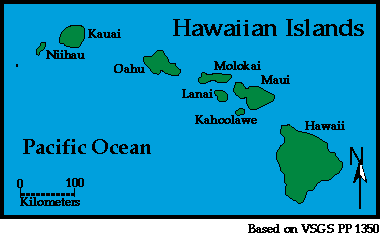
Volcanology is, quite simply, the study of volcanoes, and volcanoes are particularly useful in Geology because they provide us with a direct link to the workings of the inner Earth. Generally, volcanism occurs at the edges of tectonic plates, particularly at subduction and convection zones, where the Earth's crust is constantly being destroyed and reproduced. Not all volcanism, however, occurs at plate boundaries, and this report describes unusual, inner plate volcanism, using the specific example of the Hawaiian Islands. The University of Hawaii is the best site that I have found on this subject so far and is worth looking at for more information.
Hawaii, although an American State, is some 6000km from the west coast of Mexico and is actually the largest of eight islands forming the Hawaiian Archipelago. It sits to the south-east of this cluster of islands and as well as being the largest is also, Geologically, the youngest. Hawaii sits at approximately 30N,170W.
Hawaii today has four active volcanoes; Mauna Kea, Loihi (a sub-surface sea-mount), Kilauea and the largest, Mauna Loa. Loihi and Kilouea sit on the south-east flanks of the older and now less active Mauna Loa. At it's oldest part (the north-west), Hawaii is 430,000 years old, the youngest parts are less than 4000 years old and are, indeed, still being produced today. The ocean floor from which these volcanoes rise is much older, possibly up to 100,000,000 years, and was created some 6000km away, at the East-Pacific-Rise (running north of the Antarctic and then up through the Pacific Ocean to about the same longitude as southern Mexico). This is the closest major tectonic boundary to the modern day Hawaii and so it becomes obvious that Hawaii was not formed at a plate margin, be it constructive or destructive. The question must be asked, therefore, what is responsible for the production of the Hawaii Archipelago?
Further study of Hawaii shows that the youngest volcano (Loihi) is actively island forming and lies off the south east coast of the island, it is presently just an under water sea-mount, but will, at present rates of basalt production, produce an island (or an extension of 'Big Island') in a (geologically) short period of time. The north-west of the island is now volcanically extinct (or at least dormant) and is aged at about 430,000 years. The other seven Hawaiin islands follow a roughly straight line running towards the north-west, the oldest (Kauai) being aged at about 5.1 million years and sitting roughly 500km north-west of the Big Island.
Further study shows that a line of volcanic islands once existed to the north-west of this eigth island but have since been eroded to sub-surface sea-mounts. These islands continue the straight line from Hawaii until at a bearing of approximately (30N,170W), this line swings to the north-west-north and continues up to the Aleutian Trench. As before, the age of the sea-mounts increases with distance from Hawaii, the oldest lying to the north-west of the line (known as the Hawaiian-Emperor Chain). This information gives Geologists sufficient evidence to hypothesise the reason for Hawaii's existance and prove the theory of the phenomanon known as 'Hot Spots'.
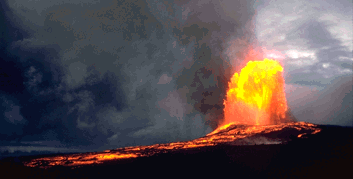
A pu'u'O'o fountain and lava flow off to the left. The fountain seen here is approximately 250m high.
The Solution - The Hot Spot Hypothesis
The ocean bed upon which the Hawaiian-Emperor chain can be found was formed at a constructive plate margin, the East-Pacific Rise. The ocean crust moved (relative to a stationary point) to the north-west and is currently being subducted off eastern Asia.
The Canadian Geologist J.T.Wilson first proposed that their may be a deep, long-lived, anonymously high temperature magma source within the mantle below the Pacific Plate. This 'hot spot' could be up to two hundred degrees hotter than expected, which would set up sufficient convection currents for the mantle to rise in a plume and, through decompression, melt, forming a magma. This (less dense) magma would then rise through the lithosphere, causing rifting and the production of a 3-4km deep magma chamber. [The term 'magma chamber' is probably a little misleading, because it is hypothesised that magma actually rises through large interconnecting chambers as opposed to a single, balloon like void.] The Magma chamber would rise, eventually sitting about 2km beneath the summit of the ensuing volcano.
As the magma reached the surface, it would cool quickly (due to the contact with water) and form interconnected, sack-like basaltic bodies known as pillow lava's. These pillow lava's would sit on all of the contact edges of the volcano, which is growing rapidly as magma (called lava on contact with the surface) adds to it's mass, and the surrounding water.
With time, these growing volcanoes (called sea-mounts) will become increasingly complex, with networks of sills, dykes, magma lakes and lateral extrusions, until, finally the volcano will break the surface of the ocean and become an island. In large volcanoes (such as Mauna Loa), the head of the magma chamber could rise up well into the root of the volcano and spread laterally, possibly forming seperate volcanoes (such as Kileaua and Loihi) on the flanks of the mother volcano.
As already explained, the Pacific Plate is moving towards the north-east. It has been hypothesised that it is moving over a stationary hot-spot (currently under the Hawaiian islands) rooted deep in the Earth's mantle. If the hot-spot had become active around 70-100 million years ago, it would have 'scorched' the oceanic crust above it, forming the very oldest sea-mounts now found in the the north-west of the Hawaiian-Emperor Chain. As the plate moved, however, these volcanoes would have been carried away from the hot-spot and would have become dormant and then extinct. New areas of volcanism would occur to the south-east of the islands just formed.
This accounts for the straight line of volcanoes running from the oldest on the north-west end of the Hawaiian-Emperor Chain to the youngest on the south east. This pattern of volcanism continued until about 43 million years ago, when the path of the Pacific Plate changed somewhat (for reasons as yet unknown). This accounts for the change in direction of the Hawaiian-Emperor Chain at (30N,170W). Since then, the Pacific Plate has moved (relatively) to the north-west, over the hot-spot, creating a chain of sea-mounts and islands.
This theory explains the Hawaiian-Emporor Chain and the active volcanism now occuring on the island of Hawaii.
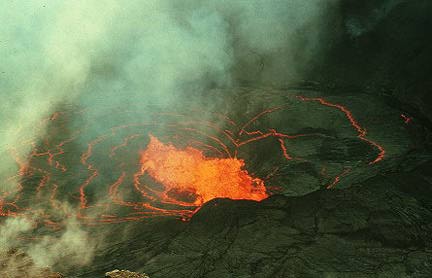
'A Puu Oo lava pond'. Us Geological Survey, February 2nd, 1996
Today, Hawaii has four (officially) active volcanoes; Mauna Kea, Mauna Loa, Kilaeua and Loihi (although Mauna Kea has not erupted for around 3,500 years and is considered by most to be dormant - incidentally, it is the only Hawaiian volcano to have undergone glaciation!).
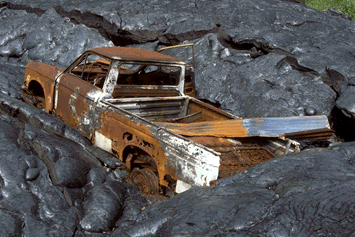
Loihi
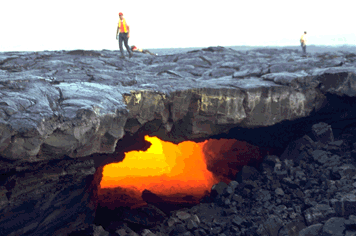
Here are some links to pages that I found particularly useful whilst researching this project, they should contain hours of further reading for anybody interested in Hawaiian geology.
Click to return to start of web site